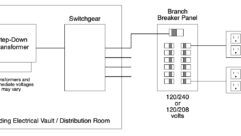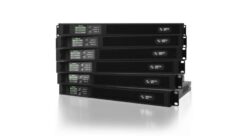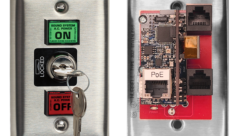The origin of balanced power: Balanced power is a revolutionary conceptthat is effective and simple.
Sep 1, 1997 12:00 PM,
Martin Glasband
Back in 1988, I was approached by a good friend, Rick Perrotta (founder ofMatchless Amplifiers), and asked to engineer the electrical system of a newmultimillion-dollar studio complex being built in Studio City, CA. His mainrequest was that the electrical system be designed in the quietest waypossible. We explored numerous avenues of design, including properearthing, star grounding and several other possibilities involving use ofisolation transformers-all of the regular stuff, but a considerable tasknonetheless.
All proceeded along the conventional path until one day, an Englishengineer approached me on coffee break and literally scolded me for beingso ignorant about the noise issue. He said, “Look at these filtercapacitors. See how they leak current into the ground from the hot side ofthe AC mains? (See Figure A.) You need to balance the voltage across thefilters to get the noise out of the ground.” I wasn’t offended by his bluntapproach; I was elated. I could see how simple it was to address thecurrent leakage problem, and if it was true that this was the actual causeof all noise (which it wasn’t), certainly this would help me with myengineering project. But there was one issue to resolve: the electricalinspector.
So, being from that school of discipline, I took the matter up before thechief electrical inspector of Los Angeles, a fellow named Gary Wilson, whomI had known professionally for some 18 years. I pointed out sections of thecode where a pseudo-system of balanced AC had been used in hospitals, andwhen I asked for permission to try it out in a sound-recording environment,I received a resounding “NO.” The reasons he cited were instability and theinherent dangers of using an ungrounded AC system. He was right. So I wentback to the drawing board and sought out a way to ground the system to hisliking without unbalancing the voltage. That didn’t take long. I determinedthat placing a common terminal between the voltage outputs of an isolationtransformer and grounding it would likely solve everyone’s concerns. (SeeFigure B.) Fortunately, it did. After a few more discussions, Wilson and Icame up with a few installation procedures and wiring methods that wouldsatisfy his department’s safety concerns.
The project was completed a short time later. When the investors showed upfor a test run, a studio guitarist panicked when he plugged in his Marshallamp and announced to all that it was broken. He went back to his rig andplayed around with the guitar, then nearly blew out all of the glass in theroom. After the initial trauma had passed, he calmly announced to allpresent that this was the first studio he had ever been in where his ampmade no noise. He only thought it was broken. This event was a harbinger ofthings to come.
That’s how balanced power was born. The irony of it was that it wasconceived in its present form just to satisfy the grounding concerns of anelectrical inspector, reminiscent of “Mr. Watson, come here. There’s beenan accident.”
Little did I realize at the time that there was literally an entire powerquality industry awaiting something new and different to “step out of thebox.” And so it has. Balanced power is a revolutionary concept rapidlyapproaching its day of reckoning as more and more experts in the field areeducating themselves in its theory, effectiveness and simplicity.
Solving power quality issuesBeyond the obvious filter capacitor problem are a host of other powerquality issues and noise problems that balanced power seems to solve in amost elegant fashion. And herein also lies the simple truth aboutelectrical interference.
Where exactly does electrical interference come from? This is the age-oldquestion that has confronted many of the best engineers, who have respondedwith a perplexed and frustrated “shoot from the hip” attitude about thesubject. When investigating the causes of noise, most everyone blames poweror power-related components, such as harmonic distortion, power supplies,grounding systems, isolation transformers, non-linear loading and so on.There seem to be a myriad of issues involved, apparently enough to keep onebusy for quite some time with one’s education alone.
But as is true with most major issues, the problem itself is not theproblem but rather a symptom or consequence of a chosen architecture. Todeal with the problem of electrical interference effectively, one must lookdeeper at structure. So the first thing one must do to cure the problem ofelectrical interference is to be willing to wander off the beaten path,where conventional norms have provided us with conventional problems.
StructureLet’s look at structure. Figure C shows a typical AC circuit connected toan impedance load. Note the components. There is a hot conductor (120 V), aneutral wire (0 V) and a ground wire. Along with the load, these are theessential components of an AC circuit. Also indicated in the diagram arereactive currents that are typically present in the power circuitry withevery non-linear load application. Reactive current is basicallycapacitively discharged energy keyed to a modulating AC source, a”backwash” of non-active power. This is wasted energy that is not beingactively processed by the load. The important thing to understand here isthat reactive currents are natural phenomena. Unfortunately, the thrust ofmodern power quality engineering has been to methodically “undo” whatnature has done without examining the structure at the root of the problem.
In electrical parlance, the manner in which a signal or voltage is appliedto a load and referenced to ground is the structure of which we speak. Thiscan also be called mode. How are the voltage and current phases referenced?Where does active current flow? Where does reactive current flow? In thecase of single-phase applications, where is zero, where is it not and whereis ground? And how does one incorporate this “modality” into practicalterms so that structure can be modified to provide for a different outcome?
Let’s look again at Figure C. Notice that reactive currents have invadedour (assumed) zero reference potential (the ground). Now let’s jump toFigure D. This is called the common-mode noise circuit. Here, we areheavily relying on the power supply’s transformer for common-mode noiserejection. This is essentially the boundary where modern methods of noisesuppression end. Beyond common-mode noise is transverse-mode noise, whichis essentially noise that has no reference to ground. Its primary domain isthe ground. Perhaps more accurately stated, the hot side of the reactivecurrent circuit is the neutral conductor, which, in electrical industryparlance, has been appropriately named “the grounded conductor.”
Where it was assumed that there was no voltage present on the neutral, onlyactive current, reactive current is now present. And because reactivecurrent is applied across the source transformer’s impedance, reactivevoltage is also quantified. In tandem, reactive current times reactivevoltage equals reactive power (kVAR, reactive kilovolt-ampere). This is howa reactive voltage potential presents itself in the grounding system of anAC circuit-via the neutral-to-ground connection at the AC mains. This iswhy lifting the AC ground to equipment chassis eliminates noise.
If all of this seems confusing, don’t worry. The important thing tounderstand is that ground wires are dirty because non-linear loads create acondition where zero (ground) is not truly zero. But as originally stated,these are the consequences of a chosen architecture.
Back to the drawing boardIt’s back to basics. Let’s examine a restructured AC circuit where we havetossed out the conventional hot-neutral-ground architecture and haveinstead adopted a balanced circuit configuration. (See Figure E.) Reactivecurrents, which are the primary source of electrical interference, are nowbalanced at the grounding point.
Basically, what has been done here is to redefine zero. Actively, zero isnow defined as the mean voltage differential of the AC sine wave.Reactively, zero is defined as the sum of everything around it. Herein liesthe magic behind clean electronic circuit operation in a balanced powerenvironment. Simply stated, it works like this: By virtue of the equalpresence of inversely phased reactive power elements on the ground, noiseis virtually canceled. Ground is now a zero sum equation. There are nolonger any stray potentials around to corrupt signal circuit operations.
It sounds almost too simple, but numerous testimonials bear out thevalidity of the balanced power theory. Balanced power has been applied innumerous audio application environments with great success. Commonly, anadditional 16 dB to 20 dB of dynamic range is realized on a system-widebasis where multiple inputs and channels are mixed.
The digital worldIn the digital domain, balanced power creates a more subtle change in noisecharacteristics but an equally dramatic improvement in performance. Theissue in digital signal processing is high-frequency noise-noise thatapproaches the frequency of various digital operations. For example, thesampling rate of digital recordings is 44.1 kHz. That times the bit rateequals the rate of the data stream (approximately 700 kHz in 16-bit audio).It has been found that digital jitter is reduced by approximately one-thirdto one-half in equipment that has been tested first without and then withbalanced AC. High-frequency interference (caused primarily by switchingpower supplies and other half-current-pulse semiconductor devices) iseliminated by balanced AC architecture in a manner analogous to removingthe carrier frequency from an FM broadcast. In the case of balanced power,nulling the 60 Hz fundamental is in essence, “knocking the legs out fromunder” the high-frequency harmonics in the AC system. Everything collapses.
The futureLooking down the road at the progress of modern electronic systems, theneed forever cleaner signal circuit operations is becoming more and more acritical factor in performance situations. Accuracy and precision are thekey elements in the creation of effective technical systems of every sort.For example, MPEG2 and the newer fractal data compression algorithms arehighly sensitive to background interference. Expansion of corrupted datastreams that are so highly compressed make for unacceptable errorconditions.
Everyday harmonic distortion from switching power supplies has been knownto cause unspeakable calamities. System crashes are often caused by ACinterference and poor power. In one instance, a well-known chipmanufacturer lost literally a billion dollar’s worth of product in one runbecause of excessive harmonic AC distortion in its automated manufacturingplant. With such consequences, it’s no wonder that many manufacturers havebecome vigilant on the subject of power quality. That can become a realdistraction from the more creative tasks at hand. In dollars and cents, thecosts of poor power are almost incalculable.
In audio and video production, the concerns are not much different. Howmany live mixes have been ruined by background hum? How about nuisance humbars and something less than black video? How many hours have been wastedby engineers troubleshooting ground loops? And what about the subtle veilof IM distortion that has been ever-present noise that we have adjusted oursenses to tolerate? What would it be like to have a truly clean backgroundwith which to work? What sort of quality could we create? How muchproductivity and time could we gain?
With the inclusion of balanced power in the 1996 National Electrical Code(Article 530, Part G), the technology is no longer a myth. The advantagesof using balanced power are proven. At one time a technician might haveasked, “Do I dare use balanced AC to keep the system clean?” The questiontoday is, “Do I dare not use balanced AC?”










